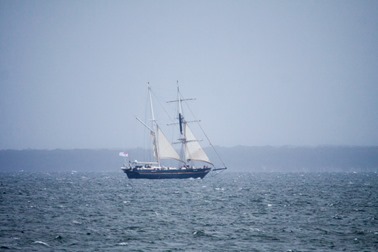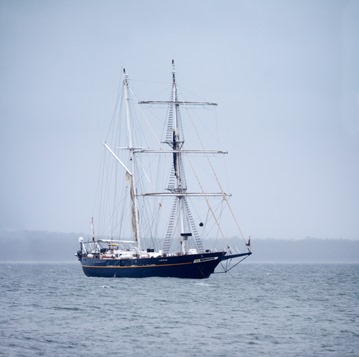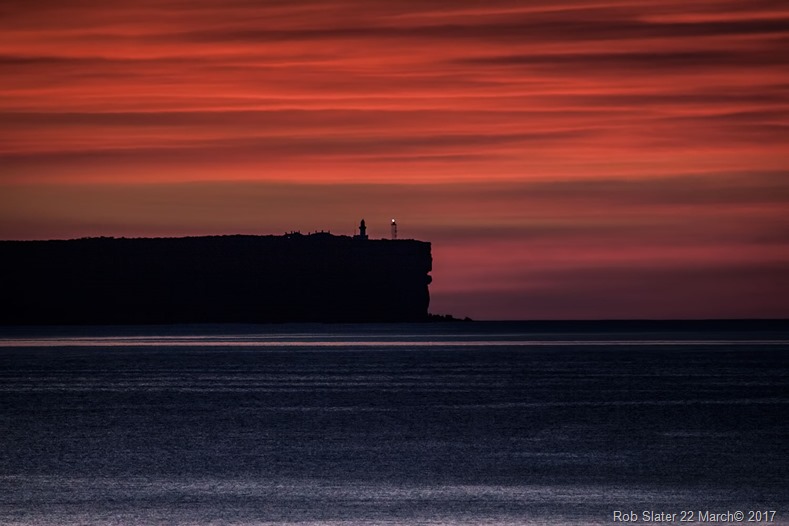 These images certainly take you back to a time before steam and diesel engines changed sea travel forever. These images certainly take you back to a time before steam and diesel engines changed sea travel forever. |
| Abreviated – Captain's Log. My intention is to remain in our anchorage overnight sheltering from the forecast 30 Kn winds and 4 m swells and sail at midday tomorrow to recommence our passage north when the conditions are expected to be moderate. |
| Full report here - https://www.youngendeavour.gov.au/captains-log/jervis-bay-10 |
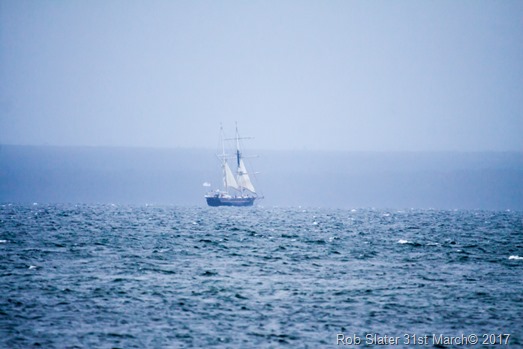 Thursday - The Young Endeavour weighted anchor before almost disappearing into the mist on the North side of the bay. Thursday - The Young Endeavour weighted anchor before almost disappearing into the mist on the North side of the bay. |
| Friday Morning - Before dawn I found her sheltered near Scottish Rocks. |
 |
 |
 The sun finally eased through the grey sky and she started to sparkle. The sun finally eased through the grey sky and she started to sparkle. |
 |
31 March 2017
Young Endeavour seeks shelter in Jervis Bay
30 March 2017
Young Endeavour–Jervis Bay
| Ships in the bay – Young Endeavour moored off Huskisson. |
| If you go down to Huskisson today you will see the two masted sailing vessel the Young Endeavour moored just off Huskisson. |
 Moored just off Huskisson, I took this before sunrise, the ship looked amazing with lights throughout her rigging. Moored just off Huskisson, I took this before sunrise, the ship looked amazing with lights throughout her rigging. |
Captains log from yesterday. Captains Log 29th March 2017 "The Ship continued on passage motor sailing northwards from Twofold Bay overnight with the crew gaining their first experiences of being on the helm, being a lookout and doing the required hourly engineering rounds. This is all about working together as a watch to maintain the required sail plan and keeping the Ship safe. The reason we were forced to motor sail was to ensure we reached Jervis Bay before the moderate northerlies we experienced this afternoon and before the expected strong Southerlies early tomorrow morning. |
 The very early morning light looked amazing. The very early morning light looked amazing. |
| Young Endeavour was a gift from the United Kingdom to the Government and people of Australia to mark the Bicentenary in 1988. Construction began on the ship in May 1986 in Lowestoft, England and on 3 August 1987 she began the long voyage to Australia with a crew which included 24 young people from Britain and Australia. The official handover ceremony took place on 25 January 1988 in the presence of their Royal Highnesses the Prince and Princess of Wales in Farm Cove, Sydney Harbour. Her arrival heralded the start of a new era of sail training in Australia. |
 The colour soon drained from the sky as the rain and clouds increased. The colour soon drained from the sky as the rain and clouds increased. |
| Click on the link below for a picture taken from the deck of the ship as she approached Point Perpendicular from the south. . |
| https://www.youngendeavour.gov.au/sites/default/files/images/blog/oBpYMcdv_photo_017.jpg |
|
|
| International Visitor |
| To go from one extreme to another we have the Spanish Air Warfare Destroyer the ESPS Christobel Colan in the bay as well. She is conducting training exercises in combination with part of the Australian Flee. Unfortunately the weather was so bad this is the best shot I could get of this ship as she slowly moved about the bay in the rain and mist. If it clears I may be able to get another clearer one... |
 |
| The name Christobel Colan is the Spanish name of the explorer known in English as Christopher Columbus |
28 March 2017
Schooner Bonnie Dundee and Hally Bailey Dismasted off Jervis Bay - 1890
| Monday 3rd February 1890 - During a violent gale off Jervis Bay the Schooner Bonnie Dundee was severly damaged loosing her masts, she was towed into Jervis Bay. | |||
| During the same storm the Schooner Hally Bailey was also dismasted off Jervis Bay and towed to Sydney, by one of Messrs, Huddart, Parkers and Co.'s steamers.
| |||
| And the tempests wild they cease | |||
| |||
 |
A correspondents words. 1904
May 1910 - Currambene Creek Huskisson.
24 March 2017
Jervis Bay and HMAS Adelaide L01
Ships in Jervis bay.
| Late yesterday afternoon I went around to Hole in the Wall and took a few pictures of the Atoll 2, a beautiful, 2 masted sailing boat, tucked in close to the shore seeking shelter from the southerly winds. |
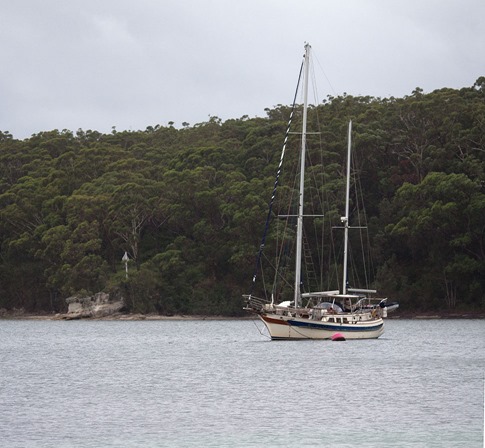 |
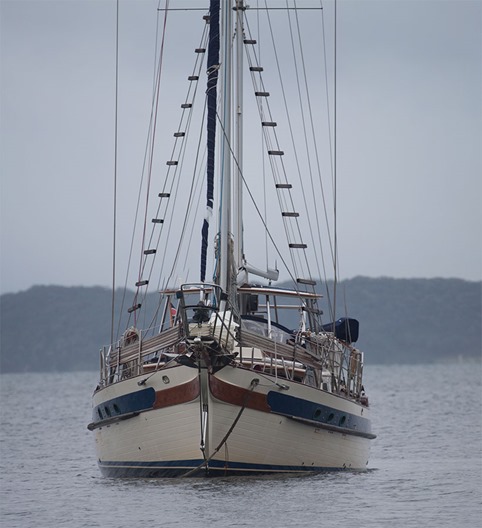 |
  |
| Moored near the Atoll 2 was the DMS navy support ship, Seahorse Horizon. |
 Seahorse Horizon behind Hole in the Wall. Seahorse Horizon behind Hole in the Wall. |
The Huskisson side of the bay was shrouded in thick mist almost obscuring the land , out of the mist appeared two largs ghost like shapes, hard to discern, but as they moved closer you could make out the distinctive shapes of two large navy ships.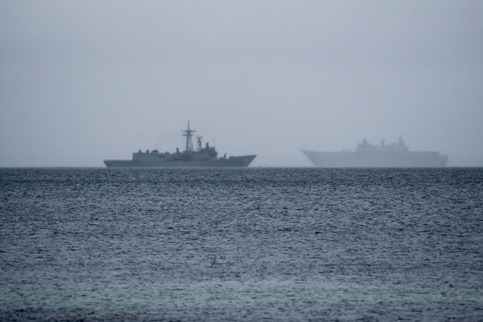 |
 |
| The ship in the foreground is the second of two Canberra-class landing helicopter dock (LHD) ships, HMAS Adelaide . The ship in the background is the Adelaide-class guided-missle Frigate HMAS Darwin. |
 |
 |
| Very early this morning I took this photograph of HMAS Adelaide under lights near Hole in the Wall. |
 |
23 March 2017
Loss of the Barque Solon
Beautiful March sunrise over Jervis Bay.
22 March 2017
Luxury Yacht Sunbeam - 1898
| January 1898 the luxury British yacht Sunbeam sailed into Jervis Bay with his Excellency and Lady Brassey and Colonel and Mrs. Bingham on board.
Tuesday 18th Jan - Early in the morning the Sunbeam was made ready to sail, at 8.40 a.m the Sunbeam with her sails spread cleared Jervis Bay Heads, the morning was dull and foggy as she steamed slowly into a fresh S.W wind. The Sunbeam was a three-masted topsail-yard schooner, iron framed and with a teak skin. Lenght 159ft, beam 27.5 ft, weight 532 tons. The name Sunbeam came from the nickname they had given to their daughter - Constantine Alberta Brassey - who had died in 1873 from scarlet fever |
 |
| REF: By Sidpickle [GFDL (http://www.gnu.org/copyleft/fdl.html) or CC BY-SA 3.0 (http://creativecommons.org/licenses/by-sa/3.0)], via Wikimedia Commons REF: https://en.wikipedia.org/wiki/Sunbeam_RYS_(1874) By Australian National Maritime Museum - http://www.anmm.gov.au/site/page.cfm?u=1464, Public Domain, https://commons.wikimedia.org/w/index.php?curid=29423480 By Sidpickle - Took photograph Hastings libraryPreviously published: From Annie Brassey's album c1887, CC BY-SA 3.0, https://commons.wikimedia.org/w/index.php?curid=29317815 |
 |

